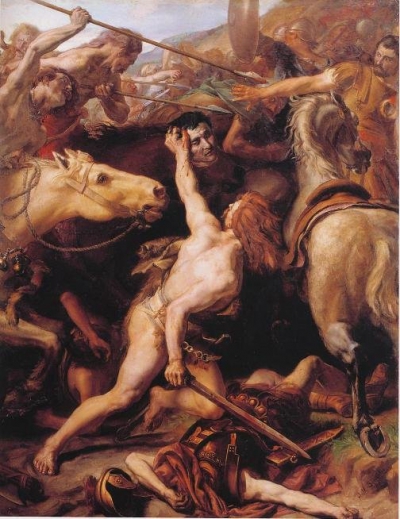The Battle of Lake Trasimene was fought when a Carthaginian force under Hannibal ambushed a Roman army commanded by Gaius Flaminius on 21 June 217 BC, during the Second Punic War. It took place on the north shore of Lake Trasimene, to the east of Cortona, and resulted in a heavy defeat for the Romans.
After the end of the First Punic War in 241 BC, in 219 BC Hannibal, ruler of the Carthaginian territories in south-east Iberia, besieged, captured and sacked the Roman-protected Iberian town of Saguntum. Early in 218 BC Rome issued a declaration of war and Hannibal left Iberia, crossed the Alps, and arrived in Cisalpine Gaul (northern Italy) later that year. The Romans rushed reinforcements north from Sicily but were defeated at the Battle of the Trebia.
The following spring the Romans positioned two armies, one on each side of the Apennines, but were surprised when the Carthaginians crossed the mountains by a difficult but unguarded route. The Carthaginians moved south into Etruria, plundering, razing the villages and killing all adult males encountered. Flaminius, in charge of the nearest Roman army, set off in pursuit. Hannibal arranged an ambush on the north shore of Lake Trasimene and trapped the Romans, killing or capturing all 25,000 of them. Several days later the Carthaginians wiped out the entire cavalry of the other Roman army, who were not yet aware of the disaster. This destruction of an entire army as a result of ambush by an entire other army is widely considered a unique occurrence. The Carthaginians continued their march through Etruria, then crossed to Umbria and marched south into Apulia, in the hope of winning over some of the ethnic Greek and Italic city-states of southern Italy.
News of the defeat caused a panic in Rome and led to the election of Quintus Fabius Maximus Verrucosus as dictator, but, impatient with his "Fabian strategy" of avoiding pitched conflict and relying instead on guerrilla tactics, the next year the Romans elected Lucius Aemilius Paullus and Gaius Terentius Varro as consuls. These more aggressive commanders engaged Hannibal at the Battle of Cannae in 216 BCE, a third disaster for Rome that was followed by thirteen more years of war.
Gaius Flaminius (c. 275 BC – 217 BC) was a leading Roman politician in the third century BC. Twice consul, in 223 and 217, Flaminius is notable for the Lex Flaminia, a land reform passed in 232, the construction of the Circus Flaminius in 221, and his death at the hands of Hannibal's army at the Battle of Lake Trasimene in 217, during the Second Punic War. Flaminius is celebrated by ancient sources as being a skilled orator and a man possessed of great piety, strength, and determination. He is, however, simultaneously criticised by ancient writers such as Cicero and Livy for his popular policies and disregard of Roman traditions, particularly during the terms of his tribunate and second consulship.

 English
English  español
español  français
français  português
português  русский
русский  العربية
العربية  简体中文
简体中文 
